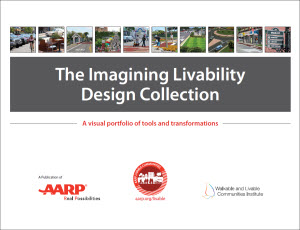 As part of its work to raise awareness about livability, AARP , in partnership with the Walkable and Livable Communities Institute has published a visual portfolio to encourage communities of all sizes to provide safe walkable streets, age-friendly housing and transportation options, access to services, and opportunities for residents of all ages to participate in community life.
As part of its work to raise awareness about livability, AARP , in partnership with the Walkable and Livable Communities Institute has published a visual portfolio to encourage communities of all sizes to provide safe walkable streets, age-friendly housing and transportation options, access to services, and opportunities for residents of all ages to participate in community life.
The toolkit includes numerous renderings aimed at inspiring community members and local leaders to imagine the potential livability of streets, while reinforcing how the built environment can be changed to benefit people of all ages and abilities.
The portfolio is arranged by cost and level of commitment required and is divided into two sections: Tools and Transformations. The Tools section lists a diverse number of short-term and mid-range treatments for creating age-friendly environments. These include a plethora of traffic calming features such as bike lanes, crossing islands, curb extensions, and chicanes, along with lane narrowing, parklets, and pedestrian-scaled lighting. It also includes case studies of successful implementation from across the country. The "Transformations" section shows real locations visited between 2010 and 2015 and visualizations, developed in collaboration with the communities, of how these communities could be transformed through the lens of pedestrian-oriented, bike friendly, and place-oriented design. The guide makes the case for the proposed large-scale transformations via their capacity to increase business income, property values, and new development. It also makes the case for their capacity to decrease vehicle crashes, pedestrian injuries and fatalities, reduced medical costs, as well as improved air quality and overall public health.